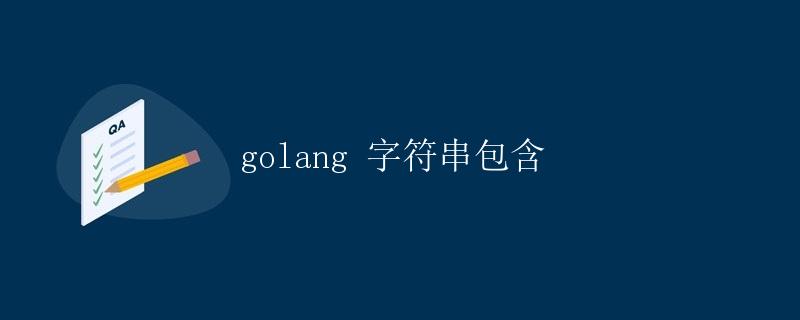golang 字符串包含

在编程中,字符串包含是一个常见的操作,通常用于检查一个字符串是否包含另一个字符串。在Go语言中,我们可以使用strings包来实现字符串包含的功能。本文将详细介绍如何在Go语言中判断一个字符串是否包含另一个字符串,并且包含一些示例代码和运行结果。
strings.Contains函数
Go语言中的strings包提供了一个Contains函数,用于判断一个字符串是否包含另一个字符串。其函数签名如下:
func Contains(s, substr string) bool
其中,参数s是要搜索的字符串,参数substr是要查找的子字符串。如果s包含substr,则返回true;否则返回false。
接下来,我们将通过一些示例代码来演示strings.Contains函数的使用。
示例1
package main
import (
"fmt"
"strings"
)
func main() {
str := "hello world"
substr := "world"
if strings.Contains(str, substr) {
fmt.Printf("'%s' contains '%s'", str, substr)
} else {
fmt.Printf("'%s' does not contain '%s'", str, substr)
}
}
运行结果:
'hello world' contains 'world'
在这个示例中,我们定义了一个字符串str为"hello world",并定义了一个子字符串substr为"world"。然后我们使用strings.Contains函数来检查str是否包含substr,最终输出为'hello world' contains 'world'。
示例2
package main
import (
"fmt"
"strings"
)
func main() {
str := "hello world"
substr := "foo"
if strings.Contains(str, substr) {
fmt.Printf("'%s' contains '%s'", str, substr)
} else {
fmt.Printf("'%s' does not contain '%s'", str, substr)
}
}
运行结果:
'hello world' does not contain 'foo'
在这个示例中,我们将子字符串substr改为"foo",结果为'hello world' does not contain 'foo'。
strings.ContainsAny函数
除了strings.Contains函数,Go语言的strings包还提供了一个ContainsAny函数,用于判断一个字符串是否包含任意一个字符在另一个字符串中。其函数签名如下:
func ContainsAny(s, chars string) bool
其中,参数s是要搜索的字符串,参数chars是包含的字符集合。如果s包含chars中的任意一个字符,则返回true;否则返回false。
接下来,我们将通过一些示例代码来演示strings.ContainsAny函数的使用。
示例3
package main
import (
"fmt"
"strings"
)
func main() {
str := "hello world"
chars := "aeiou"
if strings.ContainsAny(str, chars) {
fmt.Printf("'%s' contains any character in '%s'", str, chars)
} else {
fmt.Printf("'%s' does not contain any character in '%s'", str, chars)
}
}
运行结果:
'hello world' contains any character in 'aeiou'
在这个示例中,我们定义了一个字符串str为"hello world",并定义了一组字符chars为"aeiou"。然后我们使用strings.ContainsAny函数来检查str是否包含chars中的任意一个字符,最终输出为'hello world' contains any character in 'aeiou'。
示例4
package main
import (
"fmt"
"strings"
)
func main() {
str := "hello world"
chars := "123456"
if strings.ContainsAny(str, chars) {
fmt.Printf("'%s' contains any character in '%s'", str, chars)
} else {
fmt.Printf("'%s' does not contain any character in '%s'", str, chars)
}
}
运行结果:
'hello world' does not contain any character in '123456'
在这个示例中,我们将字符集合chars改为"123456",结果为'hello world' does not contain any character in '123456'。
strings.Index函数
另一个常用的字符串包含操作是查找一个字符串在另一个字符串中的位置。Go语言的strings包提供了一个Index函数来实现这个功能。其函数签名如下:
func Index(s, substr string) int
其中,参数s是要搜索的字符串,参数substr是要查找的子字符串。如果substr在s中,则返回substr在s中第一次出现的位置索引;否则返回-1。
接下来,我们将通过一些示例代码来演示strings.Index函数的使用。
示例5
package main
import (
"fmt"
"strings"
)
func main() {
str := "hello world"
substr := "world"
index := strings.Index(str, substr)
if index != -1 {
fmt.Printf("'%s' contains '%s' at position %d", str, substr, index)
} else {
fmt.Printf("'%s' does not contain '%s'", str, substr)
}
}
运行结果:
'hello world' contains 'world' at position 6
在这个示例中,我们使用strings.Index函数来查找子字符串"world"在字符串"hello world"中的位置索引,并输出为'hello world' contains 'world' at position 6。
示例6
package main
import (
"fmt"
"strings"
)
func main() {
str := "hello world"
substr := "foo"
index := strings.Index(str, substr)
if index != -1 {
fmt.Printf("'%s' contains '%s' at position %d", str, substr, index)
} else {
fmt.Printf("'%s' does not contain '%s'", str, substr)
}
}
运行结果:
'hello world' does not contain 'foo'
在这个示例中,我们将子字符串substr改为"foo",结果为'hello world' does not contain 'foo'。
总结
通过本文的介绋,我们了解了在Go语言中如何判断一个字符串是否包含另一个字符串,以及如何确定某个字符串中的位置索引。通过使用strings.Contains、strings.ContainsAny和strings.Index函数,我们可以方便地实现字符串包含操作。在实际编程中,这些函数可以帮助我们处理字符串相关的逻辑,提高代码的效率和可读性。
 极客教程
极客教程